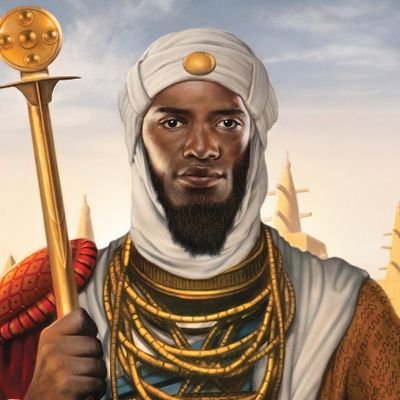Mansa Musa, also known as Musa I of Mali, was born around 1280 into the royal Keita dynasty of the Mali Empire in West Africa. Though the exact details of his early life are scarce, he was a devout Muslim and well-educated, likely trained in administration, military tactics, and Islamic teachings.
He ascended to the throne in 1312, succeeding his predecessor, Mansa Abu Bakr II, who is said to have embarked on an expedition across the Atlantic Ocean and never returned. Musa, who was Abu Bakr’s deputy or kankoro-sigui (a high-ranking official), assumed the throne in his absence. His reign marked the height of Mali’s power and global influence.
The Mali Empire under Mansa Musa
Under Mansa Musa’s leadership, the Mali Empire expanded to become one of the largest and wealthiest empires in the world during the 14th century. At its peak, the empire included parts of modern-day Mali, Senegal, Gambia, Guinea, Niger, Nigeria, Chad, and Mauritania.
Mansa Musa’s rule was characterized by political stability, economic prosperity, and cultural development. He capitalized on Mali’s rich natural resources, especially gold and salt, which were the backbone of the trans-Saharan trade network. Through careful governance, Musa ensured that trade routes remained secure and prosperous, and he implemented administrative reforms to centralize power and enhance the empire’s infrastructure.
The Famous Pilgrimage to Mecca
In 1324, Mansa Musa undertook a legendary pilgrimage (Hajj) to Mecca, which catapulted him to international fame. His caravan reportedly included tens of thousands of soldiers, officials, and servants, as well as camels carrying vast amounts of gold. Along the way, he generously distributed gold to the poor and to cities such as Cairo, Medina, and Mecca, inadvertently causing inflation in some regions due to the sheer volume of gold he spent.
The pilgrimage served not only as a demonstration of Musa’s piety but also as a strategic diplomatic mission. It established Mali’s prominence in the Muslim world and opened up new trade and scholarly networks with the Middle East and North Africa.

Cultural and Educational Achievements
One of Mansa Musa’s most significant legacies was his promotion of Islamic education and architecture. After returning from Mecca, he brought with him architects, scholars, and artisans from across the Muslim world. Among them was the famous Andalusian architect Abu Ishaq al-Sahili, who helped design some of Mali’s most iconic structures.
Musa invested heavily in building mosques, libraries, and schools. The most famous of these is the Djinguereber Mosque in Timbuktu, built in 1327, which still stands today as a UNESCO World Heritage Site. Timbuktu flourished as a center of Islamic learning and culture, attracting scholars from across Africa and the Islamic world.
Death and Legacy
Mansa Musa is believed to have died in 1337, though some sources suggest it may have been a few years later. He was succeeded by his son, Mansa Magha. Although subsequent rulers struggled to maintain the same level of prosperity and unity, Musa’s reign left an enduring legacy.
He is widely regarded as one of the wealthiest individuals in human history. His name became synonymous with wealth, wisdom, and religious devotion. Through his pilgrimage and his patronage of education and architecture, Mansa Musa helped shape the image of West Africa in the global imagination and positioned Mali as a beacon of Islamic scholarship and economic power.
Mansa Musa’s reign stands as a golden age in African history. His vision, leadership, and generosity not only transformed the Mali Empire into a superpower of its time but also left a lasting mark on global history. His life is a powerful testament to the richness of African civilizations and the far-reaching impact of cultural and intellectual exchange across continents.


